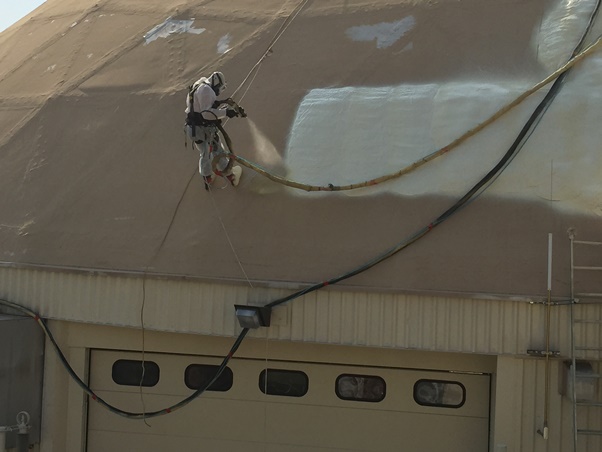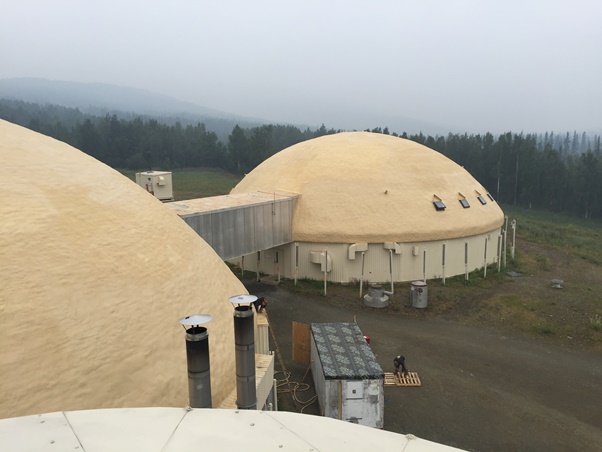Located atop Alaska’s Brooks Mountain Range near the Arctic Circle, two domed buildings sit beneath the Indian Mountain Long Range Radar Station (LRRS). The station, constructed in the 1950s to provide the U.S. Air Force with early warning of a possible Soviet Union attack, was inactivated in 1983 and re-designated as a radar site for homeland security, controlled by the Pacific Air Forces unit.
The LRRS is one of 15 radar sites maintained by regional defense contractor ARCTEC Alaska, which provides on-site specialists at each facility. The LRRS is staffed year-round by four workers, who live in one dome. Meanwhile, the other dome is a mechanical/power station. For safety reasons, the actual radar dish is at the mountaintop above the base.
Built in the 1980s after barracks were removed, the domes were designed to protect workers and equipment from brutal winter conditions in a remote area of Northern Alaska where bears greatly outnumber people! The domes, each 100 feet (30.5 m) in diameter, were built with corrosion-resistant aluminum I-beams and aluminum-skinned structural insulating panels. But extreme temperatures caused the metal to expand and contract, forcing jointing seams to break. This allowed leaks, especially when it rained or snowed.
Over the years since, many patching solutions were tried, but nothing ever completely stopped the leaks. As a result, ARCTEC and the U.S. Air Force contacted regional contractor Polyseal Insulation to develop a spray polyurethane foam (SPF) system for the entire 44,000-square-foot (4,087.7 m2) roofing area. “We approached them with the idea that it’s not going to do any good until we stop the expansion and contraction,” said Matt Wirtanen, Polyseal’s owner and estimator. “Hence, the foam on top to 'put the metal to sleep.'”
SPF, also called spray foam, has high dimensional stability and insulating properties, according to coatings manufacturer SWD Urethane, which is important since local temperatures can plunge as low as -90 °F (-67.8 °C)!
Peak Performance
Simply getting the requisite materials and equipment to the jobsite was an issue in itself. There are no roads going to the LRRS, meaning it could only be accessed by rare and expensive plane flights. “We couldn’t just fly in a part,” Wirtanen explained. “Even all of our machinery that we had, we had spare parts. We could have built a whole new machine out there!”
With materials, the crew brought in an extra 20 percent of materials to meet the projected overrun, due in part to windy conditions. “We hit it pretty much right on the money,” Wirtanen said. “We got pretty lucky.” In all, 108,000 lbs. (48,988.0 kg) of material, equipment, and accessories were transported — all by airplane.
“It was many, many months of compiling the list of things that we needed to bring,” Wirtanen said. “The list of things that we needed to bring and remember was phenomenal.” Wirtanen added that the Air Force wouldn’t provide energy drinks, such as Red Bull or Gatorade, since it considered them to be performance-enhancing substances. As such, the crew even brought 600 lbs. (272.2 kg) of its own drinks for fuel!
As with any roofing system, safety was a key consideration. To access the domes, a 16-foot (4.9 m) scaffolding system was established. When on the scaffolding, crew members were harnessed with a 10-mm (0.4 inch) rope system utilizing a Petzl mobile fall arrester. While the Occupational Safety and Health Administration (OSHA) only requires a one-rope system, Polyseal wanted to be as safe as possible, so two ropes were used. “The harnesses, ropes, and accessories were all geared for a vertical work situation,” Wirtanen said.

Besides access, proper personal protective equipment (PPE) was critical. The crew initially tried using fresh-air respirators to guard against chemical inhalation. However, due to nearby forest fires, smoke kept getting into the machines. As a result, they used Allegro’s cartridge respirators for added protection. Other PPE items included gloves, steel-toed boots, and Tyvek suits.
Dome Foam
The concept was to put the metal to sleep, but the six crew members on the job didn’t get much! They arrived in late May, when conditions had thawed enough to be more conducive to curing.
“We had sunlight 24 hours a day,” Wirtanen said, referring to summer in the extreme Arctic. “One of the applicators actually expressed surprise one day when he discovered it was 10 p.m., and he realized he had been spraying for 14 hours!”
The contractor was confident foam could stop the leaks, if applied correctly. However, this was far from easy. The existing roof had various old coatings on it from the patching attempts, which had created a questionable surface for the foam to adhere to. While the coatings could have been removed, this would have increased the job’s cost significantly.
“We had heard rumors that some were silicone-based, so that’s why we just assumed that it would have been too much to tackle to try to peel the coatings off,” Wirtanen said.
Instead, Polyseal mechanically fastened a woven monofilament, erosion-control mesh around the base of each dome. The mesh — known as the Enkamat 7020, a turf reinforcement mat from Enka Solutions — gave a better surface for the foam to adhere to the substrate, and it prevented the foam from cracking. “Basically, we wanted the building to be able to collapse underneath the foam and have the foam still stay there,” Wirtanen explained.
Using a low-pressure PH-2 hydraulic proportioner from Polyurethane Machinery Corp. (PMC), the crew applied an average of just over 4 inches (10.2 cm) of SWD Urethane’s Quik-Shield 125, a 2.5-lb. (1.1 kg) roofing foam, over the mesh on each dome. The foam was applied in three main lifts — first, a 2-inch (5.1 cm) layer, then two 1-inch (2.5-cm) layers. The sprayers adjusted their patterns, as needed, to ensure that the foam was uniformly applied as a smooth surface to allow for the even distribution of a polyurea topcoat. After the third lift, a final light pass of ~0.5 inches (1.3 cm) was applied. Density and compressive tests were conducted on the foam each day for quality assurance.
Overspray was not a major concern given the extreme remote nature of the jobsite, but the crew did have to pay attention to prevailing winds — particularly on the final pass.
“We’d come over with a very light pass that was sprayed in such a manner to give it a ‘creamy’ texture,” Wirtanen said. “To where the polyurea would come out nice. We learned how to spray according to the wind direction to not get a pebbly surface for the polyurea.”
From there, it was time for the finishing touch. Using PMC’s high-pressure PH40 hydraulic proportioner, the crew topped off the dome by applying two coats of the Quik-Shield 952 polyurea hybrid, ultraviolet (UV) resistant coating at ~80 mils (2,032.0 microns) combined. The first coat was applied in one direction, and then the second coat at a 90-degree angle from the first to ensure proper coverage in case there were any uneven spots on the foam surface.
“The military really liked the product,” Wirtanen recalled. “It was a tan color that we kind of researched and followed, and it weathered the best.”
All Clear!
With the aid of constant daylight, the crew completed the entire job in just 11 days and 670 man hours! Wirtanen said a similar assignment elsewhere had taken 840 hours, but applying best practices and lessons learned allowed them to shave that down.
In all, 76,000 lbs. (34,473 kg) of foam was sprayed. According to SWD Urethane, the foam successfully resolved the site’s issues of flexing, cracking, and leaking, and there is no longer a need for constant patch repairs.
“We ended up with a very satisfied customer at the end of it all,” said Wirtanen, adding that his team had already been contracted to repeat the job on another very similar site.
With more jobs like this, the Polyseal crew might soon be on everyone’s radar!
